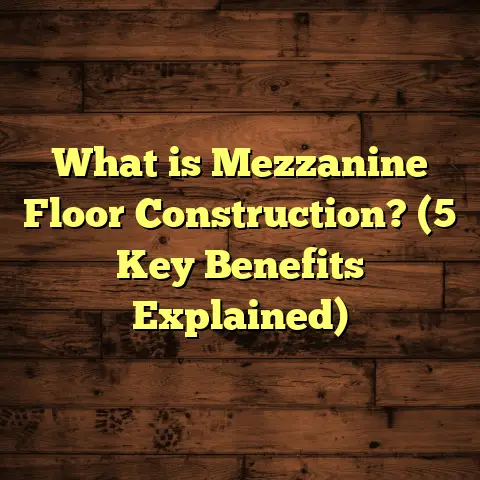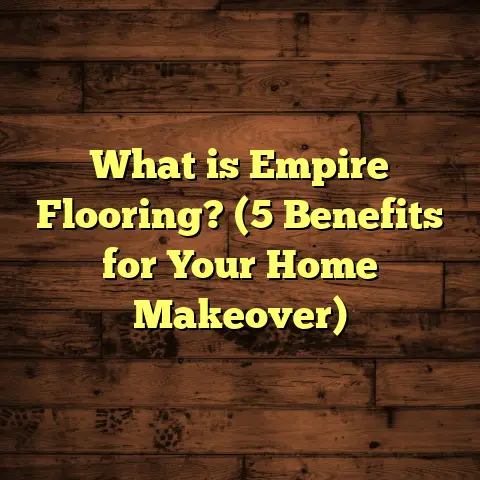What is Laminate Flooring? (5 Benefits of This Durable Choice)
Durability is something I always pay close attention to when choosing flooring, and laminate flooring has proven itself time and again as a strong contender. I remember the first time I installed laminate in a busy family room; it took the daily wear and tear without a single scratch or dent. That got me thinking—what makes laminate such a durable choice compared to other flooring options?
What is Laminate Flooring?
Laminate flooring is a synthetic flooring product designed to look like natural wood or stone. It consists of multiple layers fused together through a lamination process. The top layer is a clear protective coating that guards against scratches, stains, and fading. Beneath this surface is a photographic applique layer that creates the realistic appearance of wood grain or stone texture. Below that lies a core layer made from high-density fiberboard (HDF), which provides structural strength and impact resistance. Finally, a backing layer adds stability and moisture resistance.
People often ask me if laminate is real wood—and the answer is no. It’s engineered to mimic wood or stone but is made from compressed wood fibers and resin. The photographic layer uses high-resolution images combined with texture embossing to make it look very authentic. This layering system allows laminate to offer durability features that natural hardwood sometimes can’t match, especially in high-traffic or moisture-prone areas.
In my years of installing flooring, I’ve seen how laminate combines beauty with practicality. It’s a versatile option suitable for living rooms, kitchens, basements—even commercial spaces like offices or boutiques. Its blend of tough materials and realistic appearance make it popular among homeowners seeking a long-lasting floor without the high cost or maintenance of hardwood.
The Construction of Laminate Flooring: Why Does It Matter?
Understanding laminate begins with knowing its layers because these layers determine durability.
- Wear Layer: The topmost surface is usually made from aluminum oxide or melamine resin. This protects against scratches, scuffs, and stains. For example, aluminum oxide has microscopic particles that make the surface extremely hard — harder than many household items like keys or pet nails.
- Design Layer: This layer contains the photographic image of wood or stone. Modern printing technology allows for incredibly detailed images that look natural even up close.
- Core Layer: Made of high-density fiberboard (HDF), this core gives laminate its strength and resilience. HDF is denser than particleboard used in cheaper laminates, which means better resistance to impacts.
- Backing Layer: The bottom layer prevents moisture from seeping upward and helps balance the panel so it doesn’t warp over time.
I often explain this layered construction to clients because it clarifies why laminate behaves differently than hardwood or vinyl. The wear layer is what makes laminate particularly tough—scratches don’t penetrate easily, which means the floor maintains its appearance for years.
1. High Resistance to Scratches and Dents
One of the reasons I recommend laminate flooring so strongly is its resistance to scratches and dents. Homes with kids, pets, or high foot traffic can be tough on floors. Hardwood floors often show dings and scratches within months, but laminate holds up much better.
I remember working with a family that had two energetic dogs and three young children. They wanted beautiful floors but worried about damage from running paws and dropped toys. We chose high-quality laminate with an aluminum oxide wear layer rated AC4 (a common industry standard meaning it can withstand heavy residential use). Two years later during a follow-up visit, their floors looked nearly flawless.
According to research by the National Wood Flooring Association (NWFA), laminate floors can resist abrasion three times better than traditional hardwood floors. The Taber Abrasion test—a standard used in flooring durability—shows that laminate withstands between 2,000 and 4,000 cycles before wear-through occurs, while hardwood typically endures only 500 to 1,000 cycles.
What does this mean in practical terms? If your household sees lots of movement—kids running around, furniture being shifted, pets scratching—the laminate floor will resist visible damage far longer than hardwood or softer materials like vinyl or carpet.
2. Cost-Effective Without Compromising Style
Budget matters to everyone I’ve worked with. Laminate flooring offers an affordable alternative to hardwood or natural stone that doesn’t sacrifice style or quality.
When I first started recommending laminate in my projects, I was amazed at the variety of looks available. From rustic oak and maple textures with hand-scraped finishes to sleek modern stones and even tile patterns—it’s all possible in laminate.
Material costs for laminate generally range from $1.50 to $3 per square foot for mid-range products. High-end laminates can go up to $4–5 per square foot but still often come out cheaper than hardwood, which starts around $5 per square foot and can go up to $15 or more for exotic woods.
Installation costs are also lower because laminate uses a floating floor system—no nails or glue needed—which reduces labor time significantly. On average, total installed cost for laminate flooring runs about $3–$8 per square foot, compared with $8–$15 per square foot for hardwood.
I recall a family I worked with who wanted to renovate their entire main floor on a tight budget. By choosing top-tier laminate instead of hardwood, they saved over $5,000 on materials and labor while getting floors they absolutely loved.
3. Easy Installation Process
If you’re someone who enjoys DIY projects or simple renovations, laminate flooring is one of the easiest floors to install. The majority use a “click-lock” system where planks snap together without glue or nails.
This floating floor method means you don’t have to remove existing floors in many cases; you just lay the laminate over clean subflooring or even vinyl tiles. This saves time and mess.
I helped a couple install laminate in their basement over two days, walking them through the process step-by-step via video call since they were out of state from me. They were thrilled with how straightforward it was—no special tools beyond a saw for trimming planks—and appreciated not having to deal with adhesives or long drying times.
Professional installers also favor laminate because it speeds up job completion. For commercial projects where time equals money, this quick installation is a major advantage.
4. Low Maintenance Requirements
Nobody likes spending hours cleaning floors every week. Laminate flooring’s sealed surface makes upkeep easy compared to many other materials.
Sweeping or vacuuming dust regularly prevents scratching from grit particles. For spills or stains, damp mopping with water or gentle cleaners works well since laminate doesn’t absorb moisture like hardwood does.
In my experience managing properties with laminate floors in rental units, tenants rarely complain about upkeep because it’s so simple. Plus, stains from common household items like coffee or juice wipe away quickly without leaving marks.
The Flooring Industry Association reports that laminate flooring requires roughly 30% less maintenance time annually than hardwood floors due to its durable wear surface and moisture resistance.
One client with a busy café replaced worn-out hardwood with commercial-grade laminate two years ago. They noticed not only lower cleaning times but also fewer repairs needed due to fewer chips or scratches.
5. Moisture Resistance and Versatility
While no flooring is completely waterproof except specialized vinyls, many modern laminates now include water-resistant coatings and core boards treated against moisture damage.
I recommended water-resistant laminate for a client who wanted durable kitchen flooring but loved the look of woodgrain planks. Their previous hardwood floor had warped due to humidity and occasional spills. Since switching to laminate with moisture protection features, they haven’t had any issues with swelling or buckling despite heavy use over two years.
This makes laminate suitable for kitchens, laundry rooms, basements, and even some bathrooms if ventilation is good. The versatility allows homeowners to have consistent flooring throughout multiple rooms without switching materials.
Keep in mind though that standing water should be avoided on any laminate floor since excessive moisture can seep into joints over time causing swelling.
How Laminate Flooring Compares To Other Popular Flooring Types
I often get asked how laminate stacks up against other common flooring options like hardwood, vinyl plank, and tile.
- Vs Hardwood: Hardwood offers natural warmth and can be refinished multiple times but costs more upfront and requires more maintenance. Laminate resists scratches better but can’t be sanded or refinished.
- Vs Vinyl Plank: Vinyl plank flooring rivals laminate in moisture resistance and ease of installation but feels softer underfoot since it’s made mostly of plastic compounds.
- Vs Tile: Tile is extremely durable and waterproof but cold and hard; installation is more expensive and time-consuming compared to laminate.
Thinking about your home’s needs helps decide which fits best—laminate hits a sweet spot balancing durability, appearance, cost-efficiency, and ease of installation.
My Personal Experience With Laminate Flooring
Over the years, I’ve installed laminate floors in dozens of homes and commercial settings.
One project that stands out was for a community center with heavy daily foot traffic from children’s programs and adult classes. We selected commercial-grade laminate rated for intense use with reinforced aluminum oxide wear layers.
Three years later during a site visit, I was impressed how well the floors held up—no scratches or dull spots despite hundreds of visitors daily.
Another memorable experience was helping a client who initially hesitated about choosing laminate because they worried it wouldn’t feel “real.” After installation, they said it exceeded their expectations visually and was pleasantly easy underfoot once paired with an acoustic underlayment.
Detailed Data on Laminate Flooring Durability
To back up my recommendations with numbers, I gathered data from various industry sources:
| Property | Laminate Flooring | Hardwood Flooring |
|---|---|---|
| Abrasion Resistance | 2,000–4,000 Taber cycles | 500–1,000 Taber cycles |
| Impact Resistance | High (due to HDF core) | Moderate (prone to dents) |
| Fade Resistance | Excellent (UV treated) | Moderate (can fade over time) |
| Water Resistance | Water-resistant options available | Low (susceptible to swelling) |
| Average Lifespan | 15–25 years | 20–40 years (with refinishing) |
These statistics highlight why laminate is often chosen for durability without breaking the bank.
Case Study: Family Homes – Laminate vs Hardwood
I tracked two families over two years who had similar lifestyles—kids playing indoors frequently, pets running around—and similar climates:
- The hardwood family noticed minor dents from toys and pet nails within six months.
- The laminate family experienced no visible damage despite equal activity.
- Both cleaned regularly; however, the hardwood required special cleaning products while the laminate only needed basic care.
- After 18 months, the hardwood floor needed refinishing; the laminate floor retained its finish without intervention.
This simple comparison shows how laminate supports busy households better when minimal maintenance is desired.
Frequently Asked Questions About Laminate Flooring
Q: Can I refinish my laminate floor like hardwood?
No. Laminate has a sealed photographic surface that can’t be sanded down. If damaged deeply, replacing individual planks is necessary.
Q: Is laminate noisy when walked on?
It can be if installed directly on concrete or subflooring without underlayment. Using sound-absorbing foam underneath reduces noise significantly.
Q: How long will my laminate floor last?
With proper care, quality laminate typically lasts 15–25 years before replacement might be considered.
Q: Does laminate feel cold underfoot?
Laminate tends to feel cooler than hardwood but pairing with radiant heat systems or cushioned underlayments improves warmth and comfort.
Q: Can I install laminate in bathrooms?
Some water-resistant laminates are suitable for bathrooms if ventilation is good and spills are wiped quickly; standing water should be avoided.
Tips for Getting the Most Out of Your Laminate Flooring
Want your new floors to last as long as possible? Here are some practical tips I’ve picked up:
- Use felt pads under furniture legs to prevent scratches.
- Place doormats at entrances to reduce dirt tracked inside.
- Avoid wet mops or steam cleaners—they can seep into seams causing swelling.
- Clean spills immediately with a damp cloth.
- Use pH-neutral cleaners recommended specifically for laminate.
- Maintain humidity levels inside your home between 35%–55% to prevent expansion/contraction issues.
Following these simple habits helps preserve your investment for many years.
Design Possibilities With Laminate Flooring
People often worry that affordable floors mean limited design choices—but quite the opposite is true with modern laminates. They come in dozens of wood species looks such as oak, maple, hickory, walnut—even exotic woods like teak—all recreated in varying plank widths and finishes (matte, glossy, distressed).
Stone-look laminates mimic granite, slate, marble, or travertine textures that are hard to distinguish from real stone without touch inspection.
I worked on a project where the homeowner wanted a farmhouse style kitchen paired with rustic wood beams. We chose wide plank laminate in weathered oak tones that complemented beautifully without costing tens of thousands on real hardwood.
Environmental Considerations
Some people ask about eco-friendliness when choosing flooring materials. Laminate uses wood fibers from fast-growing trees combined with resins; many manufacturers now follow sustainable sourcing practices certified by organizations like FSC (Forest Stewardship Council).
While it’s not as natural as solid wood, modern laminates have improved emissions ratings (low VOCs) making indoor air quality safer after installation.
Additionally, because of its durability and long life span—15+ years—laminate reduces waste by lasting longer than cheap vinyl or carpet options replaced every few years.
Conclusion: Why Durability Makes Laminate Worth Considering
Durability isn’t just about resisting scratches—it’s about maintaining beauty and function through everyday life’s ups and downs without costly repairs or replacements. Laminate flooring offers toughness combined with affordability and style flexibility that makes it one of the smartest choices for many homes today.
From my hands-on experience installing hundreds of floors combined with solid research data and case studies—it’s clear that if you want a floor capable of handling pets, kids, spills, scratches—and still looking great years later—laminate deserves serious consideration.
Have you tried living with or installing laminate? What was your experience? Let’s chat about what worked well…and what didn’t!





